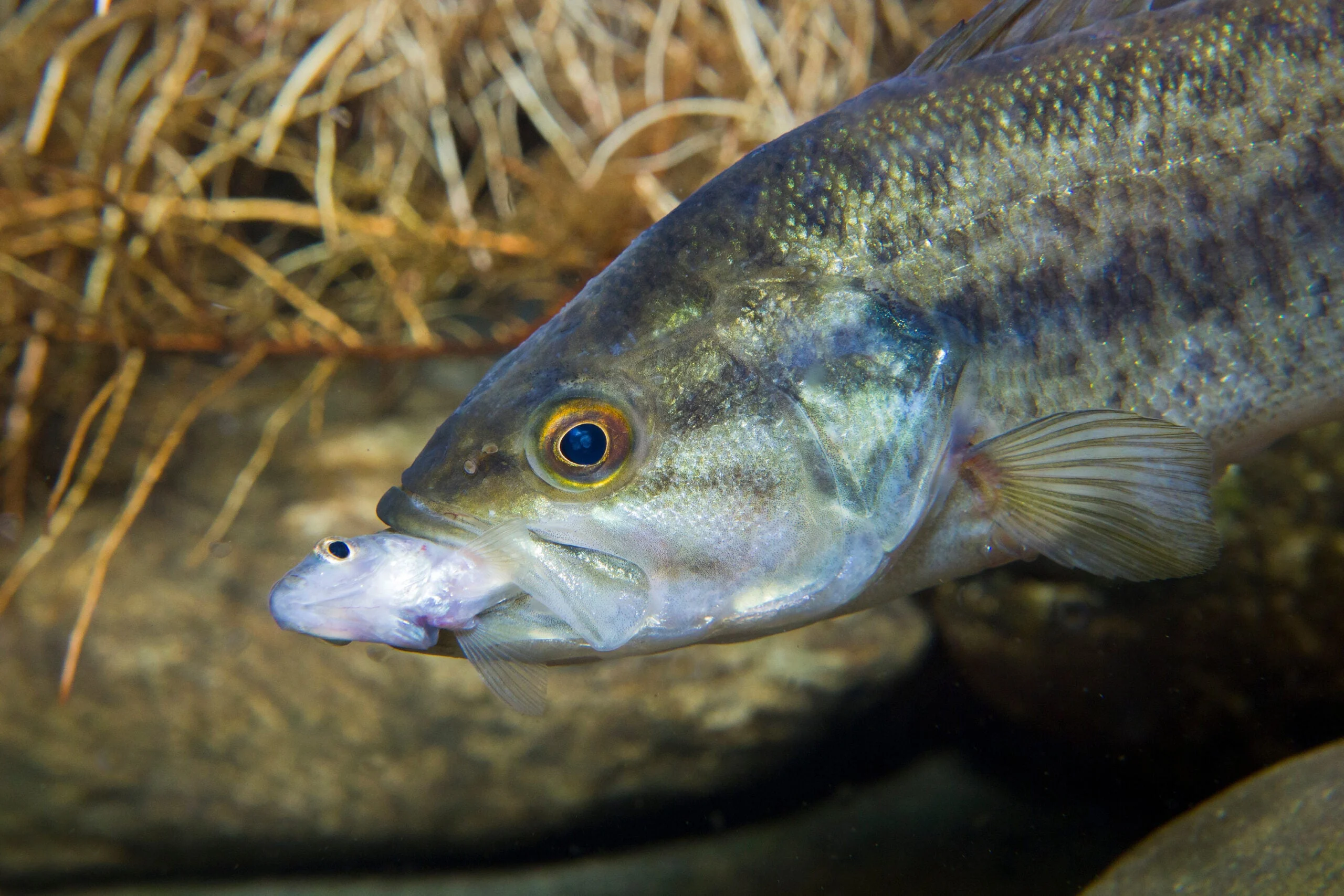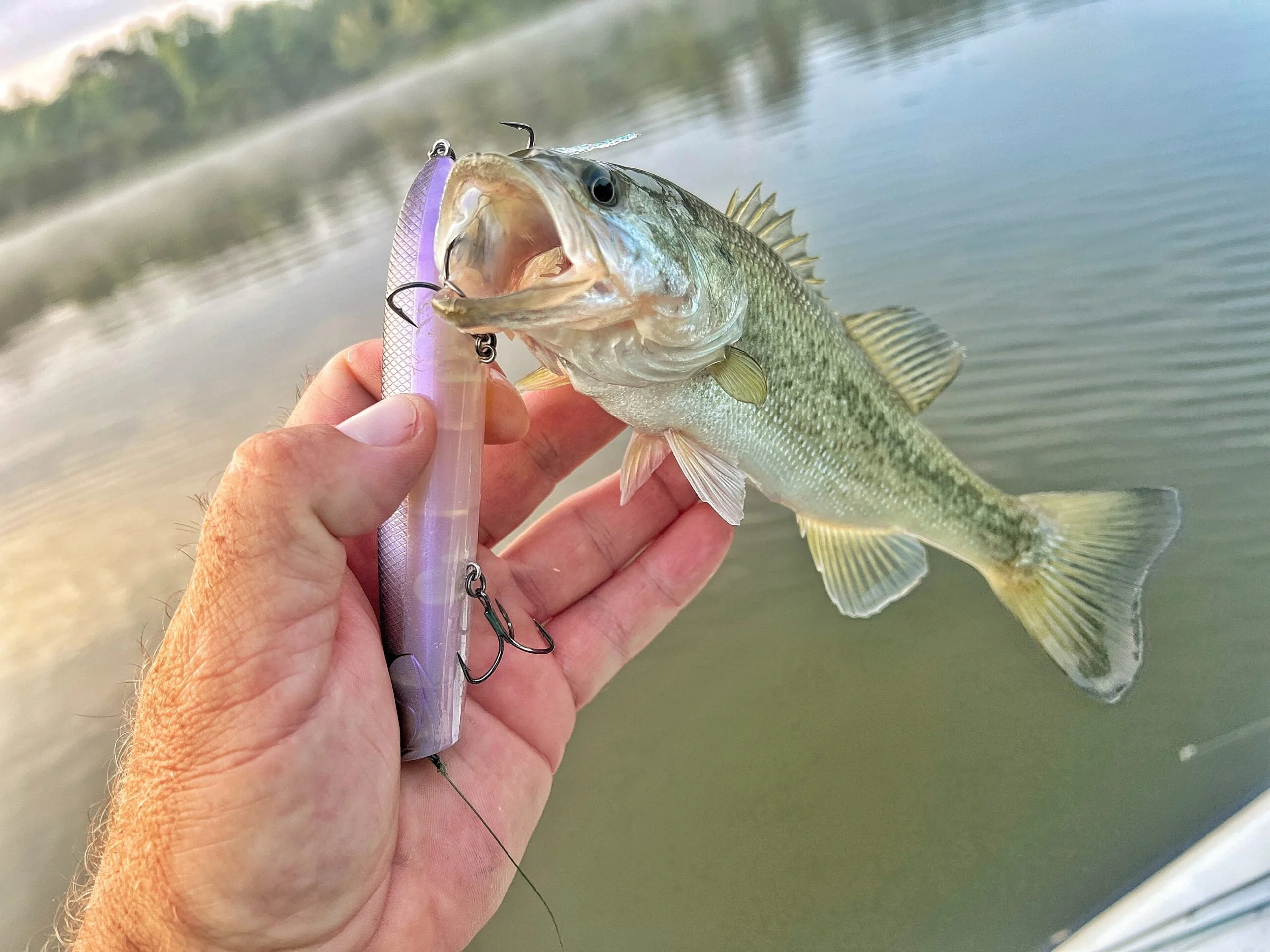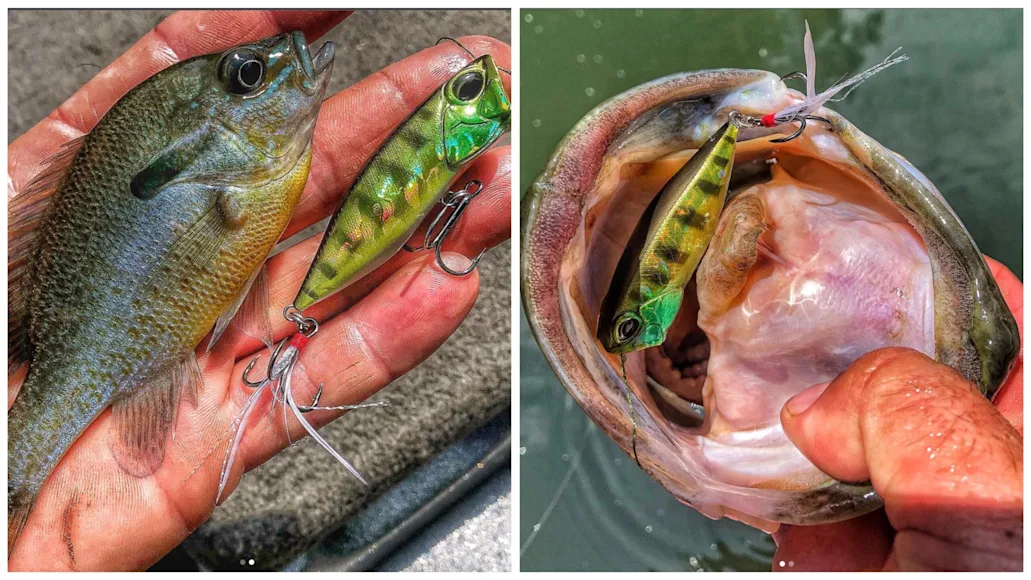We may earn revenue from the products available on this page and participate in affiliate programs. Learn more ›
Bass are opportunistic feeders. This means they will eat—or at least try to eat—almost anything that moves in the water or on the surface. If a bass is in the mood to feed, it will aggressively hunt down and attack minnows, shad, sunfish, perch, trout, and even other bass, as well as crayfish, aquatic insects, terrestrial insects, snakes, lizards, frogs, mice, and the odd duckling. A bass will readily try to engulf meals as big or even bigger than itself. But what dictates all this is the “mood” of the fish. Once you figure that out, you're on your way to answering “What do bass eat?”
When Bass Eat and Why
Because bass are cold-blooded, there are times when they have to eat aggressively and times when they hardly have to eat anything, and it all boils down to water temperature and metabolism. In colder water, a bass’s metabolism and other systems slow. In warmer water, they speed up. This means, generally speaking, that bass need more energy and eat more in warmer water and less in colder water.
Specifically, bass are more active and willing to chase baits when the water temperatures are between 60 and 80 degrees. This is the window when covering water with moving baits like spinnerbaits and buzzbaits works well. When water temps are below 60 degrees, you may need to slow your presentation by crawling a crankbait, spinnerbait, or jig. This is especially the case when water temperatures dip below 52 degrees.

When the surface water temperatures are hotter than 80 degrees, bass will either seek shelter in the shade, where they can be caught on wacky rigs and hollow body frogs, or they will move to deep water, where water temperatures are far cooler, and more likely in that ideal 60- to 80-degree range. Because of this, bass will be more active and you can go back to moving baits like deep crankbaits and swimbaits, while mixing in Texas rigged worms and jigs.
Bass are also highly sensitive to changes in barometric pressure. So they will often feed less in high-pressure situations and feed more heavily during times of low atmospheric pressure, like on the leading edge of a cold front. So, water temperature and barometric pressure are two of the main factors that determine when and why bass eat, or, as many anglers think of it colloquially, when bass are in the mood to feed. Once you understand that, then you can ask yourself, “What do bass eat?”—or more important, “What are the bass eating I’m fishing for eating right now?”
What Do Bass Eat Most Often?
Again, bass are opportunistic feeders and will eat nearly anything in their path, even other bass, if the conditions are optimal. Female bass fresh off spawning beds, for instance, will often turn on their young hatchlings (known as fry) and eat them. The male bass, often referred to as “fry guarders” during this time period, will actually attempt to get between the small school of fry to run the hungry mother off.

This cannibalistic behavior seems a bit barbaric, but it speaks to the very nature of how opportunistic bass really are when it comes to feeding. If a meal is in front of them, and they’re hungry, look out. This means that whatever forage is predominant in a fishery is likely the thing bass in that area feed on the most. Here is a short list of their favorites, and the best bass lures and baits to use for imitating them:
Baitfish
These included various minnows, shad, herring, smelt, gobies, shiners, and others, some being more common in different parts of the country. You can imitate them with live bait, crankbaits, jerkbaits, and various soft-plastic lures.
Sunfish and Crappies
Although small bass will readily attack a bluegill or crappie when feeding aggressively, these forage species are justifiably associated with trophy bass. A live bream makes a great big-bass bait (where legal; check regs), but there are also many artificial baits, including crankbaits, swimbaits, and spinnerbaits, designed to imitate them.
Crayfish
Bass will eat crayfish year-round, but this forage species is especially vulnerable in the spring, when they are breeding. A live crayfish can be a deadly bait, but, here too, there are plenty of great artificial options, especially crankbaits and creature baits.
Frogs
Most bass anglers are well aware that bass will smash a frog if it gets the chance—and that frog fishing provides some of the most fun topwater action of the year. Here again, live bait can certainly work, but there are so many great hollow-body and soft-plastic frog imitators on the market, there’s almost no reason to rig a live one.
What Bass Eat Varies Regionally
If you are a serious bass angler, you need to know what forage species exist in your neck of the woods. As noted above, bluegills and threadfin shad are more commonly eaten by bass across southern fisheries, while goby, perch, and smelt are the more typical fare in the North. Though there are a few types of forage that are more likely to be found along the coasts, like crab and other saltwater species of small prey found in brackish water, the variance of prey that bass feed on typically changes more drastically moving from south to north than from east to west.
This is because the temperatures and other conditions suitable for the survival of these baitfish and other food sources vary more north to south. Thus a bass in south Florida will chase down a golden shiner, and a smallmouth in one of the Great Lakes will gorge on goby, simply because one fish can thrive in one environment, while the other is more suited for the other.
But more to the point, you need to be able to answer “What do bass eat?” not just regionally, but for the specific body of water you’re fishing. If your lake has a rocky bottom that’s crawling with crayfish, or is covered in lily pads and swarming with frog and dragonflies, you’ll probably want to imitate that forage with your lure choice and presentation.
How to Choose Baits Based on What Bass Eat

The best thing to do when determining the best bass lures to use on a given fishery or lake is to do a little research. With a quick internet search, you can find that a lake is full of threadfin shad, for instance, and then choose a jerkbait, lipless crankbait, or spinnerbait to try to imitate the prey the bass are keying on, or match the hatch.
Be cognizant, though, that this can be dependent on the time of year as well. You may find that on a fishery full of blueback herring, you can use topwater baits to target bass relating to the herring in the summer. But in the winter, the bass may feed more on shallow crayfish as the nomadic herring move offshore. This kind of shift can even happen depending on the section of a large fishery on the same given day, with bass down the lake feeding on spawning bluegill and bass way up a creek feeding primarily on shad and crawfish.
In the end, the main thing to remember is that bass are opportunistic feeders that will try to eat anything in their paths, if they’re in the mood to feed. This mood is typically dependent on either short term or long term weather patterns. This will dictate the level of aggression of the fish, but whatever prey is present will dictate what they eat.
On a fishery full of shad, use shad imitating baits. If you’re in an area where bluegill are prevalent, make a selection based on that knowledge. If goby are the primary food source, you get the idea, and so on. The key is to not overcomplicate things. Pick out the bait that best imitates the prey the bass are most used to seeing. Most of the time, this will be the best approach.






